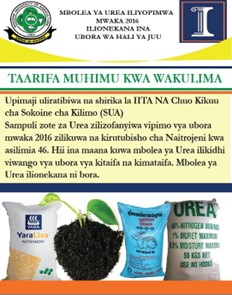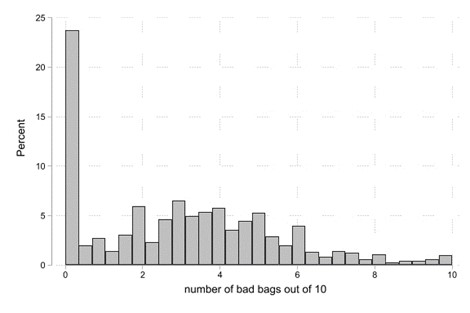
A low-touch information campaign in Tanzania improved farmers’ confidence in the quality of fertiliser, leading to an increase in purchases
Farmers in low income countries tend to purchase pesticides, fertilisers, seeds and other agricultural inputs from small local shops. All of these inputs have unobservable key attributes that determine their quality. Urea, for example, is a fertilizer with nitrogen as the active ingredient. But nitrogen content cannot be observed by the naked eye.
Most retailers where farmers purchase agricultural inputs are small, operating in largely unregulated environments with few geographically proximate competitors. These conditions contribute to a lack of trust in product quality among farmers. Farmer beliefs about the presence of bad quality fertiliser in the market have now been well-documented by researchers and practitioners, see Sanabria et al. (2013), Ashour et al. (2019), Bold et al. (2017). Farmers also report concerns about seed and herbicide quality in regional markets.
Farmers in Tanzania worry especially about being sold adulterated fertiliser – fertiliser deliberately mixed with substances like rocks or sand. Adulterated fertiliser is less agronomically effective, with lower yield response and profitability.
The paradox in this case is that a body of research has established that the quality of fertiliser (especially urea fertiliser) in these markets is consistently good with nutrient content reliably in compliance with the product’s manufacturing standards (reviewed in Michelson et al. 2023 and our previous VoxDev article).
Our study
Could a credible information campaign about fertiliser quality help farmers understand that urea fertiliser quality is good? Can we change incorrect beliefs about fertiliser quality and, by changing beliefs, improve both fertiliser demand and crop yields?
To answer this research question, we use a randomised controlled trial to evaluate the effects of a light-touch information campaign on farmer beliefs about fertiliser quality as well as their fertiliser purchases and use. We conducted our study in Tanzania’s Morogoro Region. In an earlier project in 2015-2016 (also in Morogoro), we used mystery-shoppers to purchase fertiliser from all shops in the district. We tested those 300 samples of urea and established that they were in compliance, with close to the required 46% nitrogen.
The RCT builds on those earlier results: we used a randomised design to publicise the results of these fertilizer quality tests to shops and farmers. Both studies are conducted as a collaboration between Sokoine University of Agriculture, a respected university well-known to farmers in the region, the University of Illinois, and Sussex University. We also worked with local, well-trained agronomist students and government extension officers to conduct the information intervention. These collaborations contributed to the credibility of the information campaign.
A light-touch information intervention
We divided the region’s 100 markets in two groups: 50 treatment markets and 50 control markets, with about 430 fertiliser sellers distributed across those 100 markets. In treated markets, we informed the agro-dealers, as the fertiliser sellers are known in the area that we had tested the urea fertiliser from all shops at that market and found it to be of good quality. Then we asked whether we could display a poster at the shop (Figure 1). We left pamphlets with additional information that dealers could give to their customers. Finally, we hung one poster at a central location in the market. The control markets received the same intervention, but one year later.
Figure 1: Posters given out to agro-dealers in treated markets.

Notes: Translation of the poster text: “The fertiliser test was conducted by IITA and Sokoine University of Agriculture (SUA). All Urea samples tested in 2016 were found to have 46% Nitrogen. This means that urea fertiliser met the international standards of quality. Urea fertiliser had a good quality.”
We paired each market with one or two proximate villages, for a total of 148 villages. The villages near treatment markets received information that mirrored the market treatment. We gathered all village residents and informed attendees about the urea fertiliser test results in their associated market. If farmers asked about other markets, we provided them with this information as well. We provided farmers with the same pamphlets that communicated that the testing had been conducted in partnership with Sokoine University.
Data
We collected two rounds of survey data. The baseline data collection with sellers and farmers took place in person in early 2019, preceding the information intervention. The endline data collection among farmers took place in Fall 2019 via phone. We visited the agro-dealers in person at endline early 2020 (before COVID-19). We visited a smaller sample of the villages at endline in person to collect detailed data from the farmers on their agricultural production including maize yields.
Findings
We find that farmers are concerned about fertilizer quality at baseline. We measure farmers’ beliefs as the average number of bags of urea which are bad quality out of ten one kg bags purchased across three local markets. Using this measure we find that 77% of farmers have concerns and that farmers believe that, on average, two out of ten bags in the market are of bad quality. Figure 2 presents the distribution of the number of bad bags out of ten bags according to farmers.
Figure 2: Number of bad quality bags out of ten bags, farmer survey at baseline

The information treatment improved farmers’ beliefs about urea fertiliser quality. Farmers in treatment villages significantly decrease their estimate of the prevalence of bad fertiliser in the market, an effect size of 30%. Moreover, the likelihood that a farmer has any concern at all decreases by 10 percentage points.
Changes in farmer beliefs map into behaviour change. Farmers in treatment villages are 10 percentage points more likely to purchase fertiliser in the next growing season. In particular, treatment induces farmers who have not purchased fertiliser before to give it a try, and makes farmers more likely to purchase from closer markets that they might have previously avoided. The treatment seems to re-establish their trust in those local markets. Treatment does also increase purchase of hybrid maize seed, an input that complements fertiliser use. We find no effects on reported maize yields nor on the purchase and use of other agricultural inputs. Although, since the estimations on yields are based on the smaller in-person farmer sample (~200 farmers), we are likely under-powered to detect an effect.
Finally, on the supply side, we estimate sizable seller-level impacts of treatment on the quantity of urea sold, with an effect size of almost 5%. Perhaps as expected in this price-regulated market, we find that agro-dealer prices do not change in treatment markets.
Lessons for practitioners and policymakers
Fertiliser demand and use is low in Tanzania – between 15 and 20 kg per hectare, significantly below amounts recommended by the Tanzanian government (World Development Indicators 2021). Low fertilizer use keeps crop yields low and contributes to food insecurity and poverty in rural areas.
Our study shows that an inexpensive, low-touch information campaign had an effect both on the beliefs and behaviour of market participants. We did not provide credit; we did not provide tailored advice; we did not deliver fertilisers to farmers’ doors. Farmers who had not used fertiliser before responded to credible information about fertiliser quality and bought more fertiliser. We can see those effects both in farmer reports of their own purchasing and use but also in the sales of agro-dealers operating in treatment markets.
Quality concerns are among many constraints that farmers face accessing fertiliser for their crops. Farmers also deal with uninsured production risks, output market price volatility, insufficient credit, and problems accessing the right amount of fertilisers at the right times. But our work suggests that concerns about quality may be a constraint for some farmers, keeping them from trying fertiliser on their crops. Many treated farmers still had concerns about quality at endline, meaning that the meetings and pamphlets did not fully resolve their concerns. Even so, our results suggest that a credible information campaign can change beliefs about product quality and impact behavior.
Editor's note: The research summarised in this article was partly funded by PEDL.
References
Ashour, M, D O Gilligan, J Blumer Hoel, and N Iqbal Karachiwalla (2019), “Do beliefs about herbicide quality correspond with actual quality in local markets? Evidence from Uganda.” Journal of Development Studies, 55(6): 1285– 1306.
Bold, T, K C Kaizzi, J Svensson, and D Yanagizawa-Drott (2017), “Lemon Technologies and Adoption: Measurement, Theory and Evidence from Agricultural Markets in Uganda.” Quarterly Journal of Economics, 132(3): 1055–1100.
Michelson, H, A Fairbairn, B Ellison, A Maertens, and V Manyong (2021), “Misperceived Quality: Fertilizer in Tanzania.” Journal of Development Economics, 148: 102579.
Sanabria, J, G Dimithé, and E KM Alognikou (2013), “The Quality of Fertilizer Traded in West Africa: Evidence for Stronger Control”. International Fertilizer Development Center.
World Bank (2011), World development indicators 2011. The World Bank.



